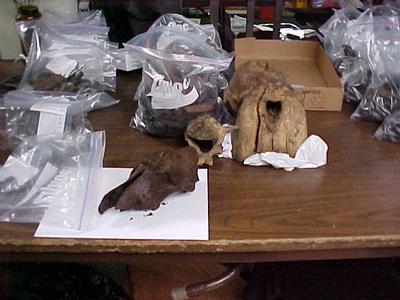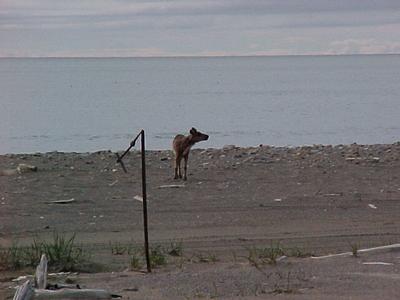13 July, 2001
We were greeted with a cold North wind and rain today, we go out unless it
is torrential. We are working our way down and around level 3. It will be
exciting to finish this level and work on level 4, but that will not begin
until next week. We have noticed many sod areas and posts, a sign of the
house. Other clues are large areas of ceramic and lithic (lithic is stone,
used for making ulus, and other cutting objects). The unit I have been
working on for most of Friday has revealed almost nothing. This is a sign
we may be on the outer edge of the area. But we may also find a great deal
as we excavate into level 4. Everything we find or do not find is telling
us something about the people who lived here over approximately 700 years
ago, just another piece of the puzzle.
Artifacts found recently: Julie has found a part of a worked bow and a
wooden doll figure. John has found a harpoon head. Margie excavated a small
ivory (walrus) figure of a seal. Amy came across part of a baleen basket.
This was very delicate and had to be carefully removed. Any artifact
starts to deteriorate as soon as it is lifted out of the ground. They have
been buried for hundreds of years. The wood starts to fall apart
(explode), the ivory starts turning color almost immediately. Some of the
wood and ivory is put in bags covered with dirt. The lithics are closed in
baggies, the faunal needs to remain open to dry. It is necessary to do
this to any finding. It will be awhile before they go to Anchorage for
analysis and need to be in the best possible shape.
We are now starting to catalog all of the findings and put them in boxes
to be shipped off to ENRI at the University of Alaska, Anchorage. Faunal
(bones) will eventually be sent to a lab in Oregon to be analyzed. Roger
has collected samples from a wooden post and some grass from Beach Ridge
026 to be radiocarbondated. These specimens are sent to a lab in Miami. It
will take approximately 3 months to find out how old the wood, grass and
fauna (bones) are.
My finds: I have found a few items worth mentioning; a fishing prong, a
punch or an awl for fishing and a bob. They are made from ivory. I have
also found quite a few lithic blades. They are very important to me. I get
extremely excited whenever I find anything, it does not matter: is it
artifact, faunal, lithic, or ceramic. Again, one of the best parts of this
team is everyone gets excited about all findings.
I have mentioned there are many different fields of study in anthropology.
There are seven people on this team, all of them having a different field
of study. Margie Goatley is from Soldota, Alaska. She is currently at the
University of Alaska, Anchorage. She is working on her thesis for her
Masters Degree in Archaeology. Her topic for her masters is Nonmetric
Variants of the Human Skull. She is studying how to identify humans from a
geographical population. She is working on using metric to measure. She
likes forensics. Margie has been part of our team since day one, but will
be leaving us to go to Scandinavia and then on to a dig in Vladavostok,
Russia, which is close to the North Korean border. She will be part of a
team studying faunal remains at that dig.
I will be discussing the rest of the teams area of study in the coming
days. I think it is important to know that there area many areas of study
in the field of anthropology (I have just learned this).
Animal Bio: The Polar Bear and Grizzly Bear
The polar and grizzly bears have evolved from a common ancestor. They are
similar in size and weight. The polar bear live alone most of the year.
They live near the coast and on the ice. Their diet consists of seals
mainly, but also will eat walrus, beluga whales, and smaller mammals, birds
and vegetation. This is a last resort, and only when food is scarce. They
can be very dangerous. Sometimes they come into villages looking for food.
They can weigh as much as 1,500 pounds. They have adapted to withstand
extremely cold Arctic weather. Not many animals can live in this
environment. They are excellent swimmers, even in the frigid waters.
Hunting is their main threat.
The grizzly also live throughout Alaska as well as Canada. They are also
called brown bears. They can weigh as much as 1,500 pounds. Their main
enemy are also humans. They have been known to live for up to 30 years,
yet this is rare. They have a great sense of smell (like the polar) and
can detect food up to a mile away. They can be extremely dangerous and can
run fast. They eat mostly vegetation, but have been known to eat moose and
caribou. They do like salmon a lot (me too).
We have not seen any bears in Wales, but there have been sightings of
grizzlies. We would not expect to see Polar bears at this time. We were
warned of sighting up along the beach a few times. They are important to
the Inupiaq as well. We saw skins of both he polar and brown bear in
Wales.

Marie and Wes are excavating with us at 079. They both live in Wales, and helped out along with Victoria.

Here are some of the samples we have drying. We think this is a wolf skull, with a walrus skull in the background.

We are in front of the light beacon that warns ships as they pass through the Bering Strait. This is the most Northwestern point on the mainland of the Western Hemisphere.

We noticed this little guy near the beacon. This reindeer was a little off course, but soon found the herd.
Contact the TEA in the field at
.
If you cannot connect through your browser, copy the
TEA's e-mail address in the "To:" line of
your favorite e-mail package.
|
